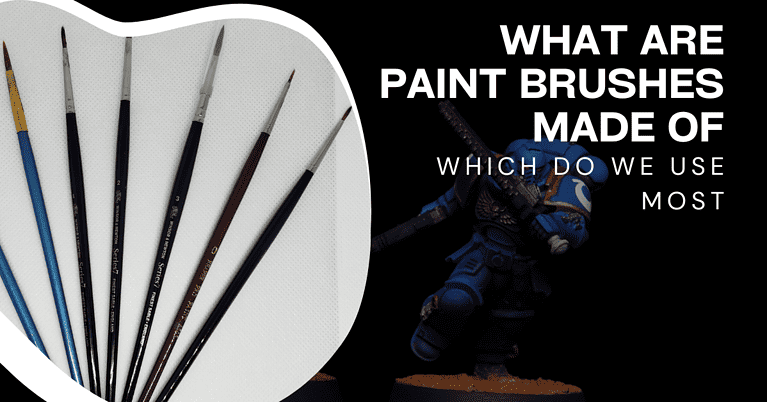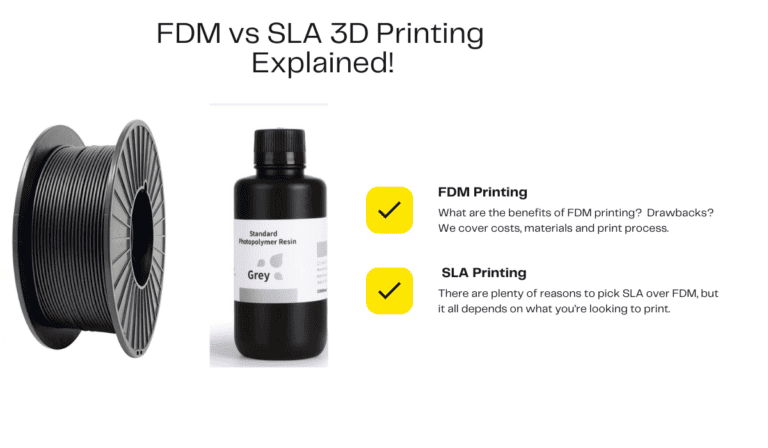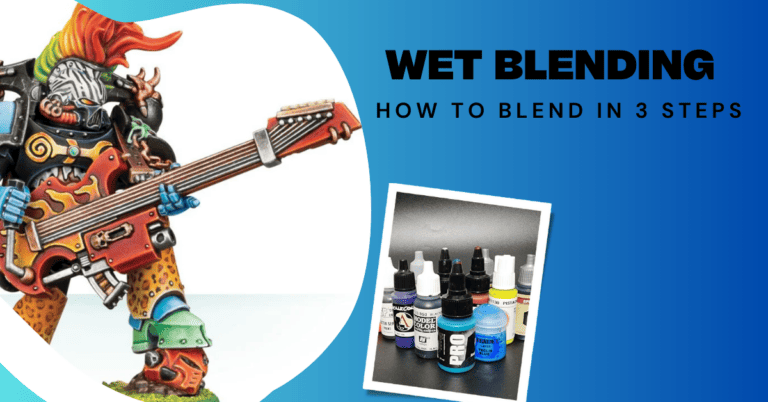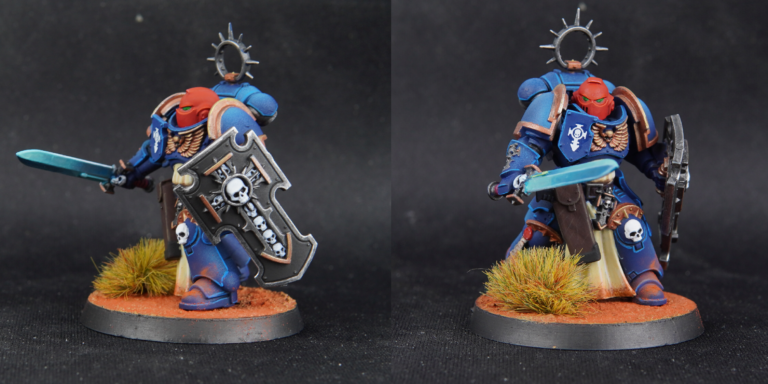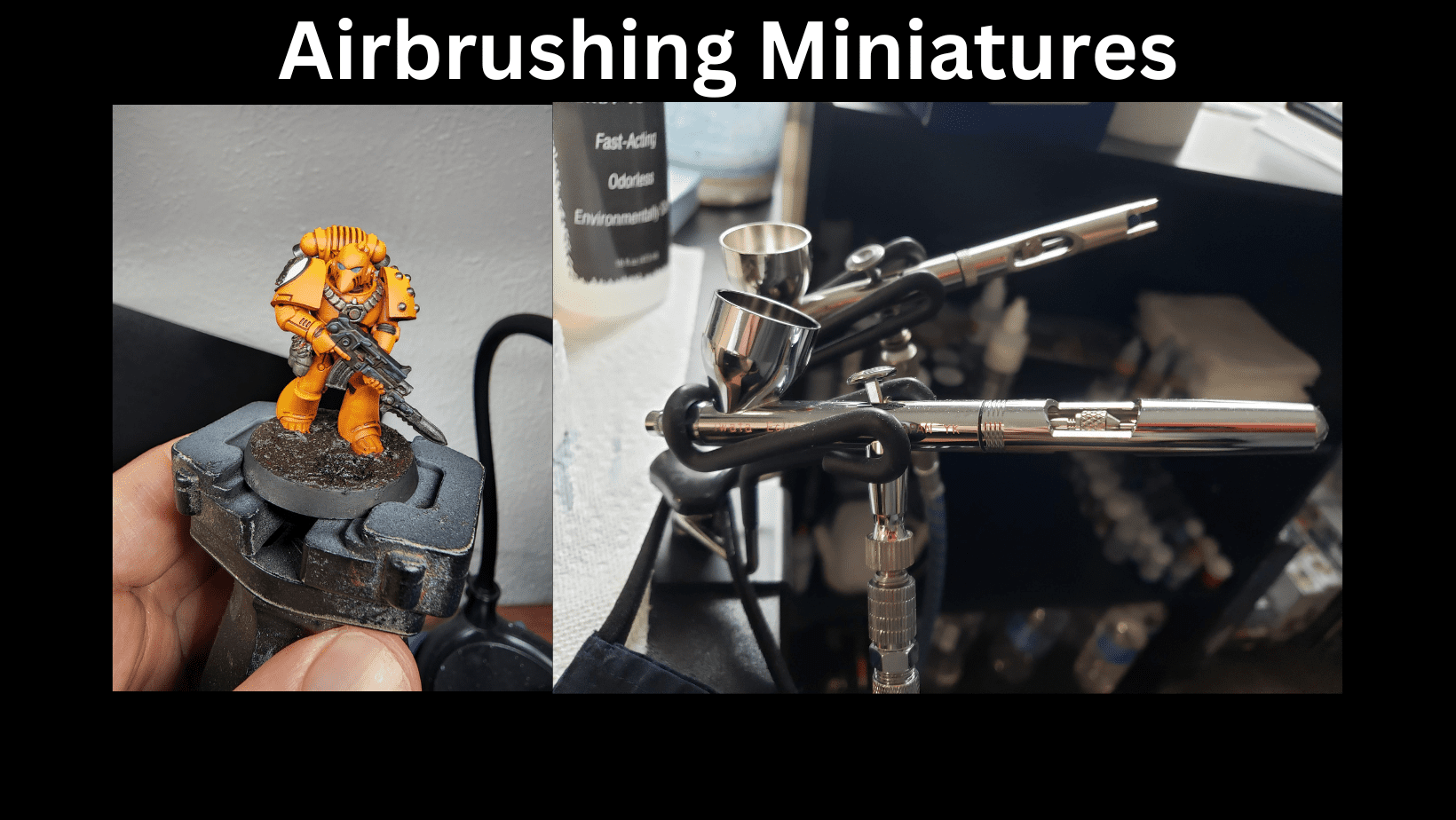The Best Airbrush Compressors for Miniature Painting – Noise Levels Measured
My airbrush compressor is a Zeny Professional airbrush compressor. This type of compressor is based off the AS-186 general family of compressors and there are many similar ones to it.
The Zeny remains my top pick for a number of reasons: Price, value, performance and durability. My situation might not be the same as yours. You might have more or less of a budget. You might want more features or a compressor that is as quiet as possible. So I’m going to break down the list into categories.
I will cover: The best overall airbrush compressor based on price and value. The best all around airbrush compressor regardless of cost (within reason). Which is the best option for someone who needs a very quiet airbrush compressor. Finally, the best low cost and portable options available.
Best Overall Value Airbrush Compressor For Miniature Painting
The Zeny Professional Airbrush Compressor is the best airbrush compressor for miniature painting. It comes with a 1/5 Horsepower engine, an air tank to hold compressed air, a pressure gauge, a moisture trap, a 3 foot hose, and a roll of teflon tape to seal any connection points.
The Zeny is one of many AS186 model air compressors that is rebranded over and over. It’s a tested and reliable model and the Zeny comes in at a great price.
It is the one I use for all my airbrushes when I miniature paint and I recommend it highly. Ive had it since 2019, here’s my amazon order:
JUST AS GOOD: The following options are nearly identical to the Zeny. Judge them differently only by price and accessories they provide in addition to the air compressor itself.
1. The F2C TC-20T Air Compressor. Identical to the Zeny in every way, including the teflon tape and hose. If this is cheaper, or the Zeny is out of stock, you can confidently buy this air compressor.
2. The Timbertech Airbrush Compressor. If the Zeny is unavailable or selling for more than the Timbertech, you might want to consider this one. Note at the time of writing the Timbertech does not come with a hose or teflon tape. It’s also slightly more expensive than the Zeny.
3. Master Airbrush Cool Runner II. This air compressor typically runs up to $50 more than the other AS-186 models. It does have a couple of fans on it that the others dont. It also has a dual airbrush holder on it if that matters to you. If you think overheating will be a problem for you, go ahead and grab this one. I can say it hasn’t been a problem for me, but I don’t airbrush for hours and hours on end.
The other thing is they list this at 47 dB which is 10 dB quieter than the others, but in real world I found them to be roughly the same in terms of how loud they run.
Best All Around High End Airbrush Compressor For Miniature Painting
The Best All Around compressor is the Iwata Power Jet Pro – But, there is a caveat (see below). I do not personally own this compressor but I have used it and it’s impressive. They are ideal for the environment I was in: An airbrush class where two people could use one compressor at the same time.
I would not say it’s much quieter than the less expensive options, but it was running two brushes so that might be it. It is absolutely a work horse that can handle whatever you throw at it.
I would only recommend this if you’re really looking to use all it’s features. Honestly the only thing it can do that the others can not, is run two airbrushes at different pressures, at the same time. That’s pretty impressive, but do you need that?
For my money, I would go in a different direction. If you want a step up from the standard, I’m doing something like the NO-NAME Tooty Airbrush Compressor. Then spend a few bucks on an airbrush air hose splitterand another airbrush hose.
The Best Quiet Airbrush Compressor For Miniature Painting
When I was first looking at compressors, this was one of the sticking points for me. What is the quietest, and how quiet is it? I ended up with the Zeny professional airbrush compressor but that’s not my pick here.
My pick for the Best Quiet Airbrush Compressor for Miniature Painting is the NO-NAME Tooty Airbrush Compressor WITH soundproofing options.
Here’s the thing, all these airbrush compressor are similar in terms of engine and horsepower. They all run around 50-60 decibels. Which isn’t very loud, but it’s not like you can find one that’s only 35 dbs. So if you need it REALLY quiet, or it’s too loud for you for some reason: soundproof it.
It needs access to airflow, but if you put it on a mat like this, and put some sound deadening foam around, it’s going to help.
The Best Low Cost and Portable Options for Airbrush Compressors
These types of airbrushes do have some pretty significant limitations, but on the other hand, if you can get into airbrushing for under $75 bucks all in, that’s phenomenal.
In this category my pick for the Best Low Cost Portable Airbrush Compressor is the Imyyds Airbrush Kit. It is a battery operated air compressor, and it comes with an airbrush and air hose.
This is a phenomenal option for quite a few use cases. First it’s inexpensive, and you get a dual action airbrush with a compressor, for not a lot of money.
The battery on it isn’t the best, and it’s a buzzy sounding air compressor. It has fairly stable air flow capacity, which surprised me.
Just understand that this thing is always working as you’re spraying. So it’s on the whole time as opposed to a traditional air compressor with an air tank that will shut off for a while when it reaches pressure.
Another thing to know is the pressure is set, you can’t tune it higher or lower. That said it’s completely fine for things like priming, varnishing and base coating miniatures.
It’s extremely portable. You can take this pretty much anywhere. That’s a huge advantage if you will use it at multiple locations.
Just As Good: Fascinated Airbrush Kit – Same thing as the above, I have not tried this one but it looks identical to the Imyyds, and it gives you more accessories. So if they’re running a sale I’d try this one.
Airbrush Compressor Stats with Noise Level and Cost
Decibels are a measure of sound levels. Higher is louder, and the range we are talking about is between 40 and 80 decibels when we talk about a typical, single piston airbrush air compressor.
For reference I’ll give you some examples of how many decibels common activities are:
- Whispering at a low tone: 30 dB
- Conversational speaking: 60 dB
- Traffic on a busy road: 70 dB
- Loud music or a typical large vacuum cleaner: 80 dB
- A motorcycle: 90 dB
- A chainsaw, a rock concert: 100 dB
It’s a pretty big range, and we’re looking at something between a normal conversation, and a vacuum cleaner hah. Realistically these are closer to a conversational 60 db or less. It’s more of a droning sound of a small motor.
None of these are anywhere near a motorcycle, and when I have my music at a reasonable volume I barely hear the motor running.
Also understand that these all have on/off operational modes. Meaning once you hit pressure, it will shut off. As you use air, it will refill and the motor engages. The motor wont run constantly.
For my measurements in this table, I used a Decibel Meter similar to this one. The Zeny, F2C and Timbertech were all tested in the same location. Others were not mine so I tested them where they were located. Acoustics might be different so this isn’t perfect conditions.
Still it’s a good sense of what we’re dealing with. Here we go:
Airbrush Compressor Decibel Levels and Costs
| BRAND | dB Listed | dB Measured | 2023 Cost |
| Zeny Professional | 59 | 55-58 | $81.98 |
| F2C TC-20T | 47 | 54-57 | $83.99 |
| Timbertech | 50 | 61-62 | $88.99 |
| Master Airbrush Cool Runner II | 47 | 48-52 | $139.99 |
| Iwata Power Jet Pro | 62 | 62-64 | $520.00 |
| NO-NAME Tooty | 47 | 51-53 | $150.00 |
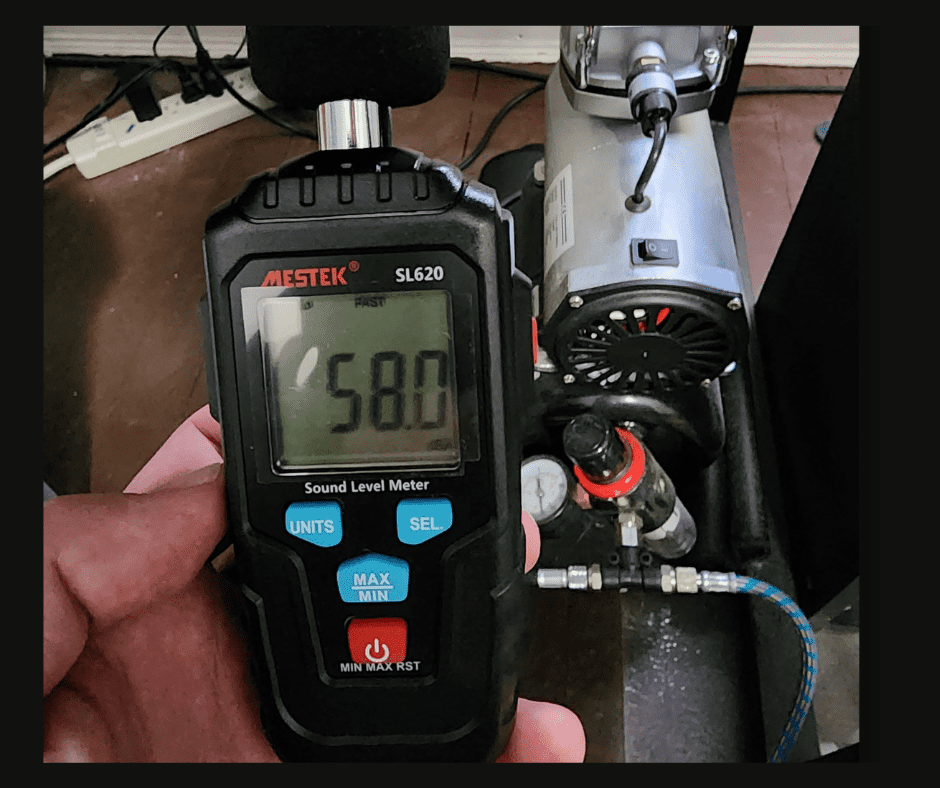
What Features Should My Airbrush Compressor Have For Miniature Painting?
The most important features include: Air Tank, Pressure Gauge, Water Trap and a fan.
Airbrush Compressor Tanks:
One of the more common questions is “do I need an air tank on my airbrush compressor for miniature painting?” Yes you should get one with an air tank, but no you do not absolutely need one.
Meaning: if you get one without a tank, it will still do the job of supplying air to the airbrush, but you want an air tank because of the benefits it gives you.
The main benefit is a more stable air pressure, and the other benefit is it allows for the engine to shut down for longer once the tank is full.
When painting miniatures there will be times when a nice stable air pressure is needed. So the recommendation is to pay a bit extra for an air compressor with an air tank.
Air Compressor Pressure Gauge:
This is an adjustable valve on the compressor that you attach the hose to. The pressure gauge is how you will set your desired air pressure. In miniature painting that is usually between 15 – 30 PSI.
A pressure gauge is another feature that is not absolutely necessary but very highly recommended. All my picks for best airbrush compressor for miniature painting have a pressure gauge.
It’s also worth noting that some airbrushes have a MAC valve on them that performs the same function.
Air Compressor Water Trap:
An air filter water trap is typically a part of the pressure gauge as it sits between the hose and compressor. The goal is to remove or reduce any condensation and water from the line.
Not a huge deal either way, but again most airbrush compressors come with one, and all my recommendations for best airbrush compressor for miniature painting has one.
Air Compressor Fans:
Cooling fans are becoming more popular on airbrush compressors. They keep the engine from running too hot. If you’re running it for very long periods they are more impactful, but again not absolutely necessary.
Types of Air Brush Compressors
Dual Piston Compressors vs Single Piston Compressors:
For miniature painting, a single piston compressor is the most commonly used. They give you enough air pressure and along with an air tank, the pressure is stable.
A single piston compressor is not as loud, less expensive, and perfectly adequate for a hobby painter. Every airbrush compressor in this list is a single piston compressor.
I’m mostly dealing with hobbyists on this site so the best airbrush compressors will be the best suited for miniature painting, gundams, modeling and crafting.
Dual Piston compressors are a more powerful air compressor and would be better for longer term use or professionals who have it running all day. If you’re in that category the best airbrush compressor for you might be dual piston.
Air Regulators vs Bleed Valves
Adjusting the PSI
If you have an airbrush with a gauge on it you can easily regulate air pressure. Just pull up the knob, twist left or right to raise or lower the pressure.
PSI for miniature painting is usually between 15 and 30. You will also hear people refer to operating pressure in terms of “bar”. Bar is a term for air pressure. One bar is around 14.5 psi. So if you hear someone say they set their airbrush compressors operating pressure at 2 bar, it’s around 30 PSI.
Not every airbrush compressor has a way to adjust the PSI. Just be aware if you don’t get one with a way to change the PSI, you can get an airbrush with a MAC valve on it like the Iwata Hi Line series. The MAC will allow you to adjust the PSI on the airbrush itself.
Pressure Gauge
As mentioned above, the gauge will allow you to regulate the PSI of the air compressor. Not every air compressor will have this, but every one in my list of best airbrush compressor does.
If you have access to an air compressor without it, look into an airbrush with a MAC valve to regulate pressure.
The pressure regulation valves are a common feature on airbrush compressors. It’s important to check that the one you’re considering has one before buying it. They are very useful and you’ll need it as you progress in the hobby.
I don’t change my pressure much but there are absolutely times when you want to lower or raise it.
Tank Capacity and Pressure Release Valve
The airbrush compressor will usually have an air tank between 1 and 3 liters. Larger air tanks hold more, and can supply air pressure longer without the engine running.
While an air tank is important to keep the air pressure even and smooth, the size is not as big of a concern for miniature painting.
All the tanks should be able to keep up with however much airbrushing you will be doing. The real variable is how often the engine has to kick in. If you have a small tank and use the brush often, the engine will go on regularly.
I should also mention here the tank has a pressure release valve on it. On mine you simply pull up on the ring and it releases the air.
I’m not sure how important it is to do that, but in theory it’s less pressure on the compressor and connections if you release the air when you’re done airbrushing. If you dont, my experience is that the air will dissipate slowly.
Honestly I don’t use the release very much. What I tend to do is clean my airbrushes, and then when they’re done I’ll shut the compressor, and simply run air through my airbrush to dry it off and release all the air from the tank.
Most airbrush compressors will have a release valve if it has a tank. In fact I think all of them do that I have seen. Just know that it’s not the only way to let the air out.
Hose Length and Fittings
Length is a personal preference and depends on your work space. Too short is unworkable, but too long and you will have a lot of clutter with the hose.
The airbrush compressor I bought came with a 6 foot hose. I also bought a second hose at 10 feet for my other airbrush. For me the 6′ is perfect. 10 was too much but it’s fine for now.
Just be aware some hoses can develop a leak. The compressed air might escape through the connection at the air tank, or moisture trap, or airbrush.
Fittings: the standards are BSP (British Standard Pipe) and NPT (National Pipe Thread) in 1/8 inch and 1/4 inch. There are adaptors if you need them readily available.
So for example most fittings on airbrush compressors are BSP. If you buy a Badger airbrush which is a US based company, the fitting is NPT.
The hose can connect to the airbrush compressor as normal, but the airbrush fitting would need an adaptor like these.
Noise Level for Airbrush Air Compressors
A standard single piston 1/5 HP compressor with an air tank will reach between 45 and 65 decibels. My testing showed the typical range in the mid 50’s. I was able to reduce that slightly when I placed the compressor on a rubber mat.
You can also further reduce the sound with sound dampening materials like foam, acoustic panels, or soundproofing vinyl.
The engine will go off when pressure is reached in the air tank, so the sound is intermittent and dependent on how much you are using the airbrush.
Can I use a car compressor for an airbrush?
You can use any compressor for an airbrush if it meets the following requirements:
- The compressor provides between 15 and 50 PSI of pressure. More or less would not work with most airbrushes.
- The compressor has connections that can accommodate your airbrush. Typically airbrush connections are either BSP (British Standard Pipe) and NPT (National Pipe Thread) in 1/8 inch and 1/4 inch. Note there are adaptors but you’ll need to see if the hose connection can support these.
Understand that even if those conditions are met you will likely get sub optimal performance, but it might be all you need to do basic work.
A gravity feed airbrush is not very complicated. All it requires is compressed air and paint. Ideally the pressure should be somewhere around 25 – 35 PSI.
Removing moisture in an airbrush compressor
Moisture filters and moisture traps are on most airbrush compressors. As for how important they are, depends on the conditions around it. If the airbrush compressor is pulling in humid air with a lot of condensation, it’s more useful.
I airbrush with acrylics, which are water based. So water wont necessarily hurt anything. It can contribute to further thinning the paint, which I suppose you don’t want.
If you end up with any air compressor on this list, it will have the moisture filter on the moisture trap. I don’t think about mine very much at all. You might be in a different situation.
If you need to further reduce moisture, a dehumidifier might be something to consider. You can run it wherever the airbrush compressor is, and take the moisture out of the air. Between that and a moisture trap you shouldn’t have trouble.
What is used to connect the airbrush hose to the compressor?
The airbrush compressor has a connection off the tank or engine. These connections are typically BSP or NPT connections. Most airbrush brands have the same connections. A compatible hose will have that same connection, and it screws on to the fittings.
Note also that you can use things like bees wax or teflon tape on the fittings to make them more air tight. This will give you more use time since the air will not slowly leak from the connections.
Many compressors will also have their own pressure regulation valves and moisture trap coming right off the air tank. In those cases the hose connects to the pressure regulator.
The best airbrush compressors will have multiple connections to use multiple airbrushes. You can also buy a splitter to attach to your compressor. This allows for more hose attachments and an airbrush can go on the other end of each.
Finding the right airbrush compressor for you is about learning what you might want to do with it. A good start is picking something from this list of best airbrush compressors for miniature painting. Getting a simple gravity feed airbrush, and a compatible hose if the compressor doesnt come with one.
Once you’re ready, you can add another air brush, another hose and splitter to accommodate both, or a quick release valve to swap between them.
A quick release valve just goes on the end of your air hose. You put the female end on each of your airbrushes. When you want to swap, you can quickly take one air brush off and put the other on. No second hose needed.
Last Thoughts on Airbrush Compressors
Dont be overwhelmed. I remember feeling like I wasn’t ready to start airbrushing miniatures. I had been painting miniatures for almost a year when I finally took the plunge.
What I can tell you is that I completely made the right call. The airbrush is a great tool and I love using it. Pick the right airbrush compressor for you from this list. Pick the right airbrush for you. Get some primer, get some paint, and get started.

